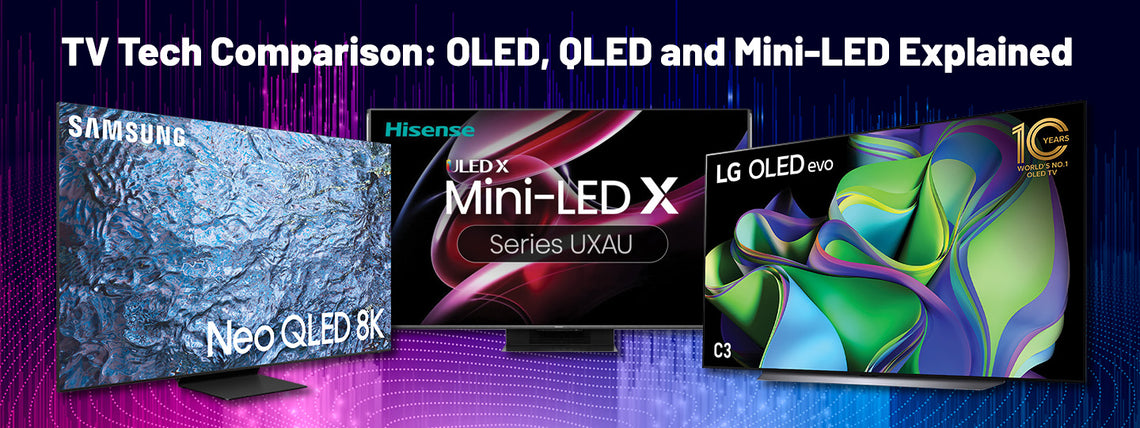Hold up - I don’t even know what LED means?
LED stands for Light-Emitting Diode, which is a technology that dates back to the ancient 1960s. LED is a tiny digital light bulb that uses semiconductors to produce light rather than the processes used in the incandescent or fluorescent bulb.
When referring to TVs LED refers to the TV’s illumination. Your TV typically has two panels, a front translucent LCD panel where the TV image shows and a rear panel with LED lights. Just as a lamp illuminated old-fashioned slides in a photo projector, the LED lights illuminate the image onto the panel in front of it. Essentially more LEDs mean more precise scene lighting, higher contrast and a better looking image overall.
The illumination of a TV can be either Edge Lit (where the LEDs are along the edges of the panel) or Direct Backlighting (where the LEDs are directly behind the panel). The advantage of Direct Backlighting is that there is less light bleed, which is where the light is less bright when the light source is further away. Even better than Direct Backlighting is what's known as "full array", which has many more LEDs on the back that 'move' or 'illuminate' with the image as it moves, eliminating light bleed for a crisp and bold picture.
OLED TVs
OLED stands for Organic Light-Emitting Diode. Instead of semiconductor, and OLED uses organic electroluminescent material that produces light when electrified. A normal LED or mini-LED is essentially a dimmable light bulb, and OLED is like a smarter, coloured dimmable bulb capable of producing any colour at any brightness level or no brightness at all. As a result a 4K OLED TV consists of a single panel with 8 million OLEDs, with no backlighting needed.
Since each OLED pixel can produce its own adjustable light, OLED TVs produce a wider range of colours, more precise contrast and the deepest black. This sounds great, and it is since OLEDs top the market in picture quality. Browse our range of OLED TVs.
QLED TVs
The Q in QLED stands for Quantum Dot, which is a tiny semiconductor nanocrystal smaller than 10 nanometers. To give you an idea on how tiny that is, a human hair measures around 80,000 - 100,000 nanometers. Each of these tiny quantum dots is capable of emitting either red, green or blue, from which billions of colours can be created. QLED TVs include a panel of quantum dots that sits between the LCD panel and the LED lighting. This heightens the TV display’s overall colour accuracy and brightness, creates deeper blacks and enhances HDR contrast.
In plain language: QLED TVs are standard LCD TVs with better colour brightness and contrast, making them good for rooms that are brightly lit.
See our range of QLED smart TVs.
Mini-LED TVs
Mini-LEDs are simply LEDs that are much smaller than the standard size so many more of them can fit in the LED panel of the TV. Groups of LEDs in the TV form what’s calling “dimming zones'' whose brightness is adjusted to correspond to the needs of the scenes being displayed on the screen. Smaller LEDs means more LEDs which means more dimming zones, which equals more precise scene lighting, eliminating light bleed into areas of an image otherwise requiring little to no illumination, higher contrast and a better overall image. Mini LED, though still relatively new technology, will be seen in most mainstream brands coming to market this year under various names.
Most important to note is that Mini LED is likely to only be available in Step-Up Panels such NanoCell and Quantum Dot Technology, not entry level UHD Panels considering this technology is predominantly designed to compete with OLED. Explore the latest Mini-LED TVs.
Explore Further
That was your quick primer on OLED, QLED and Mini-LED — three of the key display technologies you'll see in today’s TVs. If you're still weighing up which one suits your room, lifestyle or budget, we’ve got more to help.
Read our full guide to OLED TVs to explore what makes OLED panels stand out for cinematic contrast, deep blacks and immersive colour. Or learn more about QNED — LG’s hybrid tech that blends Mini-LED and Quantum Dot for bright rooms.
When you’re ready to see the difference in person, find your local Bi-Rite store and chat with one of our TV experts. We’ll help you match the right tech to your space — no jargon, no guesswork.


